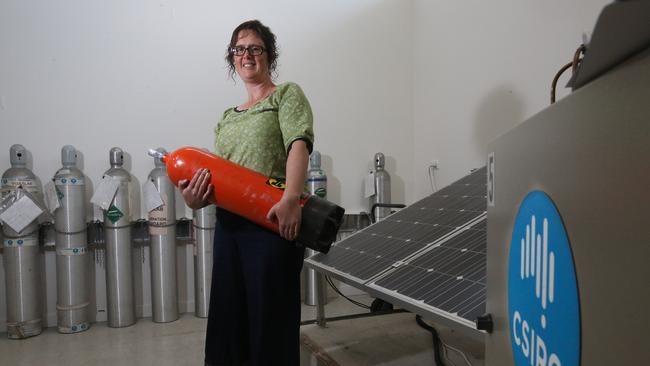CO2 levels fly high even as airlines don’t
The slump in air travel and stand down of industry because of the COVID-19 pandemic have failed to stop the rise of atmospheric carbon dioxide levels.

The slump in air travel, stand down of industry and restrictions on personal movements because of the COVID-19 pandemic have failed to stop the rise of atmospheric carbon dioxide levels or lead to big improvements in air quality in Australia’s major centres.
Carbon dioxide levels are still rising at the southern hemisphere’s main measuring station at Cape Grim on the northwest tip of Tasmania.
Scientists say any long-term change in CO2 levels caused by the pandemic will be hidden in the “noise” of natural variability. It is the same story in the northern hemisphere, despite a collapse in economic activity estimated to have cost almost $US4 trillion in lost trade, ended 147 million full-time jobs and caused the biggest drop in greenhouse gas emissions.
Climate scientists say carbon dioxide emissions in 2020 will be the same as in 2006 and that to meet targets set by the Paris Agreement, the same cuts caused by the pandemic must be repeated every year for 30 years.

Latest figures on air travel show total flight numbers are down 47.4 per cent across the world. In Australia, flight numbers are down 74.7 per cent, in the US down 44.3 per cent. In China, flight numbers are now down only 6.6 per cent.
Meanwhile, state environmental protection agencies say air quality measurements in Sydney and Melbourne are good. However, the EPAs do not consider this an environmental improvement because air quality is usually very high in the cities.
Zoe Loh, senior research scientist at the CSIRO Climate Science Centre, said there was undoubtedly a real and significant drop in anthropogenic (fossil fuel) CO2 emissions because of the pandemic. This was a direct result of government policies across many countries confining their populations to inhibit the spread of COVID-19, Ms Loh said.
The magnitude of those transient emissions reductions is currently estimated at between 3 and 7 per cent compared with 2019.
Despite this, Ms Loh said, “it is highly unlikely to be large enough to be readily distinguishable from natural variability in measurements of total CO2’’.
CSIRO measurements show that more CO2 accumulated in the atmosphere between January and July 2020 than during the same period in 2017 or 2018.
Australia’s big bushfires this year are estimated to have added about 830 million tonnes of carbon dioxide to the atmosphere but this is not expected to have any long-term impact because the CO2 will be reabsorbed by new tree growth.
Ms Loh said reductions of between 20 to 25 per cent will be necessary for the impact to be seen above ordinary fluctuations.
The natural variation in the rate of growth of CO2 in the atmosphere is about one part per million per annum. The level of atmospheric carbon dioxide at Cape Grim is now about 410 parts per million, up from 408.3 ppm in January 2020.
Since the station first began measurements in 1976, CO2 levels have increased by almost 25 per cent. The increase is believed to come from burning fossil fuels and other industrial processes.
Much of the impact of COVID-19 on travel and industrial activity has taken place in the northern hemisphere. International research shows emission reductions because of COVID-19 started in China in January, and peaked globally in April.
As at Cape Grim, Ms Loh said global background stations in the northern hemisphere would be unlikely to identify the impact of the COVID-19 slowdown.
A paper this month in Nature Climate Change by University of Leeds researchers said the direct effect of the pandemic-driven response and lower emissions would be “negligible”.
Lasting effects, if any, will arise only from a strategy adopted in the medium term if focused on climate-friendly initiatives.








To join the conversation, please log in. Don't have an account? Register
Join the conversation, you are commenting as Logout